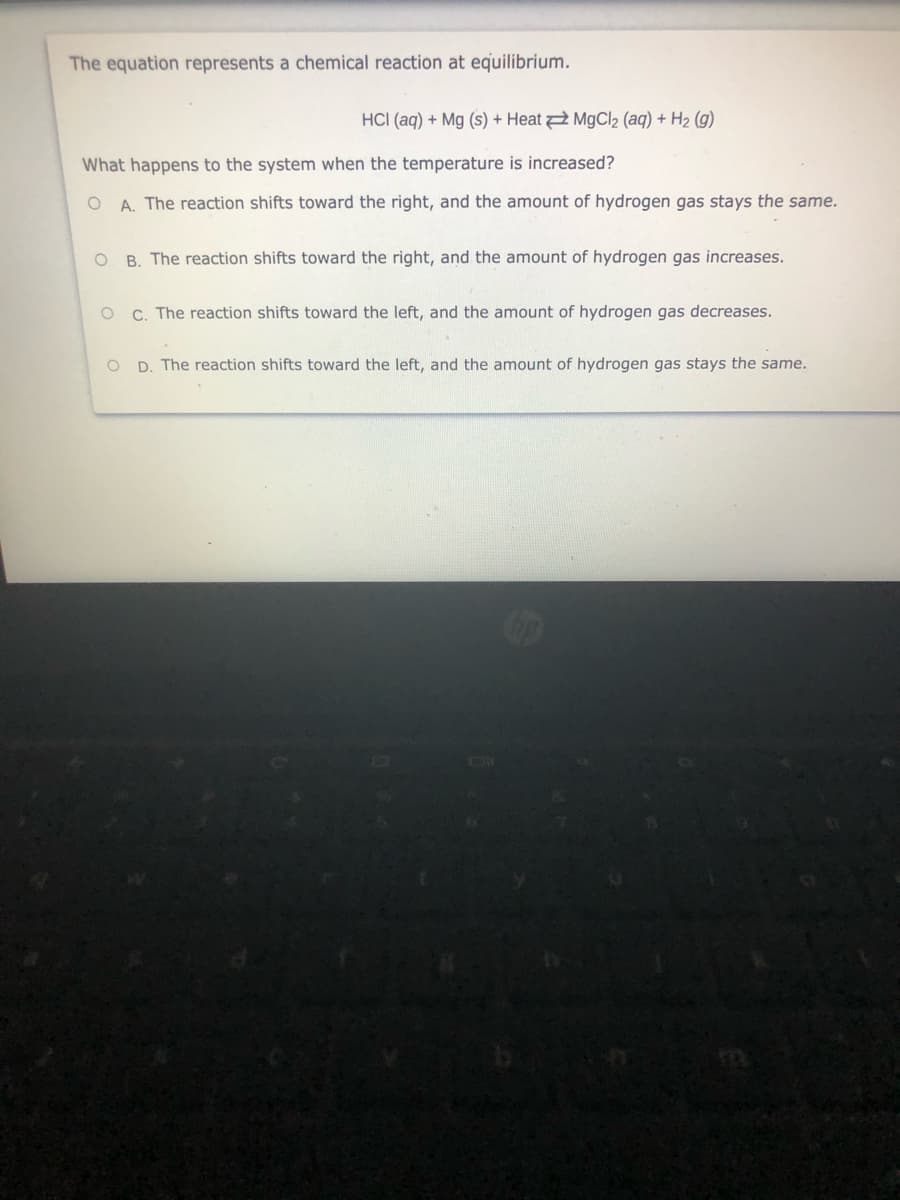The equation represents a chemical reaction at equilibrium. HCI (aq) + Mg (s) + Heat 2 MgCl2 (aq) + H2 (g) What happens to the system when the temperature is increased? O A. The reaction shifts toward the right, and the amount of hydrogen gas stays the same. O B. The reaction shifts toward the right, and the amount of hydrogen gas increases. OC. The reaction shifts toward the left, and the amount of hydrogen gas decreases. O D. The reaction shifts toward the left, and the amount of hydrogen gas stays the same.
The equation represents a chemical reaction at equilibrium. HCI (aq) + Mg (s) + Heat 2 MgCl2 (aq) + H2 (g) What happens to the system when the temperature is increased? O A. The reaction shifts toward the right, and the amount of hydrogen gas stays the same. O B. The reaction shifts toward the right, and the amount of hydrogen gas increases. OC. The reaction shifts toward the left, and the amount of hydrogen gas decreases. O D. The reaction shifts toward the left, and the amount of hydrogen gas stays the same.
Introductory Chemistry: A Foundation
9th Edition
ISBN:9781337399425
Author:Steven S. Zumdahl, Donald J. DeCoste
Publisher:Steven S. Zumdahl, Donald J. DeCoste
Chapter17: Equilibrium
Section: Chapter Questions
Problem 119AP
Related questions
Question

Transcribed Image Text:The equation represents a chemical reaction at equilibrium.
HCI (aq) + Mg (s) + Heat 2 MgCl2 (aq) + H2 (g)
What happens to the system when the temperature is increased?
A. The reaction shifts toward the right, and the amount of hydrogen gas stays the same.
B. The reaction shifts toward the right, and the amount of hydrogen gas increases.
C. The reaction shifts toward the left, and the amount of hydrogen gas decreases.
O D. The reaction shifts toward the left, and the amount of hydrogen gas stays the same.
Expert Solution
This question has been solved!
Explore an expertly crafted, step-by-step solution for a thorough understanding of key concepts.
This is a popular solution!
Trending now
This is a popular solution!
Step by step
Solved in 5 steps

Knowledge Booster
Learn more about
Need a deep-dive on the concept behind this application? Look no further. Learn more about this topic, chemistry and related others by exploring similar questions and additional content below.Recommended textbooks for you

Introductory Chemistry: A Foundation
Chemistry
ISBN:
9781337399425
Author:
Steven S. Zumdahl, Donald J. DeCoste
Publisher:
Cengage Learning

World of Chemistry, 3rd edition
Chemistry
ISBN:
9781133109655
Author:
Steven S. Zumdahl, Susan L. Zumdahl, Donald J. DeCoste
Publisher:
Brooks / Cole / Cengage Learning

Chemistry: An Atoms First Approach
Chemistry
ISBN:
9781305079243
Author:
Steven S. Zumdahl, Susan A. Zumdahl
Publisher:
Cengage Learning

Introductory Chemistry: A Foundation
Chemistry
ISBN:
9781337399425
Author:
Steven S. Zumdahl, Donald J. DeCoste
Publisher:
Cengage Learning

World of Chemistry, 3rd edition
Chemistry
ISBN:
9781133109655
Author:
Steven S. Zumdahl, Susan L. Zumdahl, Donald J. DeCoste
Publisher:
Brooks / Cole / Cengage Learning

Chemistry: An Atoms First Approach
Chemistry
ISBN:
9781305079243
Author:
Steven S. Zumdahl, Susan A. Zumdahl
Publisher:
Cengage Learning


Chemistry
Chemistry
ISBN:
9781305957404
Author:
Steven S. Zumdahl, Susan A. Zumdahl, Donald J. DeCoste
Publisher:
Cengage Learning

Chemistry for Engineering Students
Chemistry
ISBN:
9781337398909
Author:
Lawrence S. Brown, Tom Holme
Publisher:
Cengage Learning